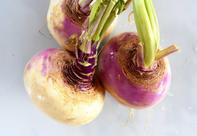
Plant Description
Turnips are native to Eastern Europe and the cooler parts of Asia. They are thought to have been cultivated by humans for 4000 years or more. Prior to that, they were collected by hunter-gatherers where they grew wild in parts of Asia.
The turnip plant has dark green leaves with slightly serrated edges on a lighter green stem. These grow about 40 to 50 cm from the top of the bulbous root at the base of the stem, which is the main source of food.
However, the leaves are also edible. The turnip root is round to oval with a taproot. Turnips have also become a popular source of animal feed and are also cultivated as a fodder.
Uses
The bulbous roots are eaten boiled, fried and roasted and the leaves are also boiled and fried or eaten raw in salads. The boiled roots also make a good mash.Soil Requirements and Preparation
Turnips like a sandy loam to loam soil that drains well and contains a good level of organic material. The soil can be slightly acid at a pH of between 5.8 and 7. It does not do well in heavy, compact soils with high clay content as this can cause root deformities, which will effect production yields.
When turnip plants are young, weeds in the plant area can cause large crop losses as young plants struggle to establish themselves. Therefore, in the months leading up to planting, a strict weed control program must be followed.
A soil sample should be taken well in advance of planting turnips, necessary organic material, lime and phosphates must be applied to the area and incorporated into the soil by ploughing to at least 500 mm, turning and mixing the soil about four to five weeks before planting to give the soil time to settle.
This can be followed immediately by a disc harrow to further prepare the topsoil, cutting any surface weed debris and levelling the area. In the final week before planting turnips, disc harrow again to kill any weeds that have taken hold and to make sure there are no soil clods in the topsoil that will hamper plant and root development.